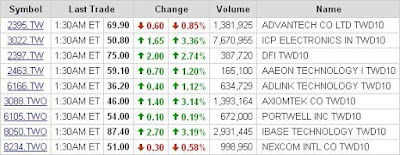Introduction
Motherboards are at the heart of any computer. However they always seem to be the forgotten part!
PCStats writes "
they [motherboards] are perpetually the team player and not the star of the show, and are generally priced as such." Despite being forgotten, motherboards are incredibly complex devices interfacing multiple components and chipsets together. And, by looking at their components, are able to give us an idea of the depth and complex integration of Taiwan's hi tech sector.
Motherboard Overview
Basic motherboards all come with a processor (CPU) connected to a north bridge chipset through a front side bus (a communications channel). The north bridge is then interfaced to a south bridge chipset which itself is interfaced to a bunch of peripheral devices, other chipsets and connectors through different communication channels e.g. PCI bus or the Low Pin Count (LPC) bus. Sometimes the CPU and the north bridge are integrated together in a single package so there is only a single system chipset on the board.
The north bridge, revealingly called the graphics and memory controller hub (GMCH) by Intel, controls all graphics and all memory modules (SO-DIMM or DIMM). The south bridge, also called the input/output controller hub (ICH) by Intel, generally controls all the other components such as the hard disk drives, keyboard, mouse, audio input and output etc.
Since most of the world's motherboards are manufactured by Taiwanese companies (e.g.
Gigabyte,
Asus or
Advantech) most of the onboard components are manufactured by Taiwanese companies. Looking at the onboard components of a motherboard (or any integrated electronics board) gives an interesting picture of some of the big players in the Taiwan market.
The Companies and their ComponentsAt a first glance, the north bridge and south bridge may be
VIA or
SiS chipsets. Both companies are Taiwanese. Although
AMD and
Intel dominate the CPU and chipset markets, both these companies, although smaller, have a presence and fill a niche.
Many of the super I/O chips are also made by Taiwanese companies.
Winbond,
ITE Tech and
ALi Corporation are all fabless design companies based in Taiwan. These companies also make an array of other products (e.g. RAID controllers by
ALi Corporation) that are also often seen on motherboards. Another fabless chipset design company is
RealTek. You may very often see
RealTek Audio codecs and Ethernet controllers on a motherboard.
One of the largest fabless design companies in Taiwan is
MediaTek.
MediaTek specialize in chipsets for communication devices like mobile phones etc.
Another interesting company is
TXC.
TXC is one of the world's largest manufacturers of crystal oscillators and timing devices. These are usually small silver colored objects with
TXC etched across the top. These timing devices are critical to the operation of the entire system.
Semiconductor Foundries, Testing and Packaging Since Taiwan is host to many fabless chipset design companies, it is not surprising then that two of the world’s largest semiconductor foundries are also Taiwanese.
Taiwan Semiconductor Electronic Corporation (
TSMC) is by far the largest.
United Micro Electronics (
UMC) comes in second. The foundries manufacture chipsets in accordance with the designs given to them from the fabless chipset design companies introduced above and others.
Another interesting company is
Siliconware Precision Industries (
SPIL) who offer semiconductor packaging and testing services to semiconductor companies around the world. Their customers include semiconductor suppliers, such as
Broadcom Corporation,
Intel Corporation,
LSI Logic Corporation,
Marvell Semiconductor Inc.,
MediaTek,
NVIDIA Corp.,SanDisk Corporation,
Powerchip Semiconductor Corp. and
Xilinx, Inc. (Source:
Reuters)
Memory ManufacturersMemory modules are also critical components for a motherboard to operate (although these modules are not necessarily integrated onto the machine). Taiwanese memory manufacturers include
A-Data,
Transcend,
Powerchip Semiconductor Corp. , and
Apacer.
In 2006
Invest in Taiwan said: “
Taiwan DRAM (dynamic random access memory) manufacturers continue to grow, as they took a 37% global market share in 2006, according to a report by market intelligence group DRAMeXchange.” The report continues saying: “
Taiwan companies comprised 9 of the top 20 memory manufacturers around the world in 2006,” and that “on the average, one of every three computers worldwide uses DRAM memory manufactured by a Taiwanese company.”
PCB Manufacturers Of course, all the components sit on the actual PCB and therefore, as can be expected, five of the largest
PCB manufacturers in the world are from Taiwan including
Unimicron,
Nanya PCB,
Compeq and
Tripod. According to the Unimicron about page, they were ranked first in the world in 2006 with over US$1.1 billion for the year.
Conclusion There are many other Taiwanese (and international) companies that provide critical components for the motherboards. However the list is too long here and this piece is meant to provide a taste only.
Looking at a motherboard does indeed provide a detailed breakdown of Taiwan’s Hi Tech sector and enables investors and technologists to understand the depth and highly integrated nature of the Taiwan’s Hi Tech sector.
